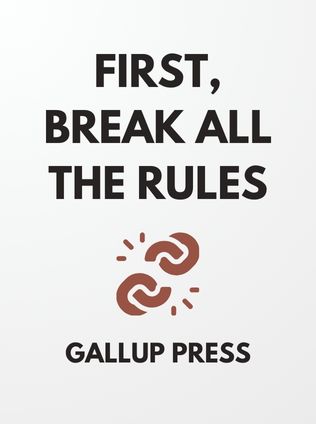
First, Break All the Rules
What the World's Greatest Managers Do Differently
By Gallup Press
Published 05/1998
About the Author
Marcus Buckingham and Curt Coffman, the authors of "First, Break All the Rules," are pioneers in the field of workplace management and employee engagement. Marcus Buckingham is a globally recognized researcher, New York Times bestselling author, and a motivational speaker known for his work on strengths-based management. His career began at Gallup, where he conducted significant research on employee engagement and workplace performance. Buckingham's insights have shaped the way organizations view talent management and have inspired countless leaders to rethink their approach to leadership and development.
Curt Coffman, co-author of this groundbreaking book, has been a leading figure at Gallup, where he spent over two decades studying the intricacies of management and employee engagement. Coffman's research has been instrumental in understanding the dynamics between managers and their teams, particularly how the quality of this relationship impacts overall employee performance and organizational success. Together, Buckingham and Coffman bring a wealth of knowledge and a fresh perspective to the subject of management, making "First, Break All the Rules" a must-read for anyone interested in leading a high-performing team.
Main Idea
"First, Break All the Rules" is a revolutionary book that challenges traditional management practices. The central thesis of the book is that the best managers in the world break conventional rules to bring out the best in their employees. Instead of trying to fix weaknesses, they focus on leveraging the strengths of each individual. This approach not only leads to higher productivity but also creates a more fulfilling and engaging workplace.
The authors argue that effective management is not about applying a one-size-fits-all approach but about understanding and nurturing the unique talents of each employee. Great managers don't follow the "Golden Rule" of treating everyone the same; instead, they treat people as individuals with distinct strengths, needs, and motivations. This personalized approach fosters a work environment where employees feel valued, engaged, and motivated to perform at their best.
The book is built on extensive research conducted by Gallup, which involved studying over 80,000 managers across different industries. The findings revealed that the most successful managers shared a common trait: they broke away from conventional management wisdom and developed their own unique styles that emphasized strengths over weaknesses. These managers understood that by focusing on what their employees naturally do well, they could achieve extraordinary results.
Table of Contents
- Measuring the Strength of Your Workplace
- The Q12 Items
- Key One: Hire Employees for Their Talents, Not for Their Skills or Knowledge
- Key Two: Define Goals, Not Processes
- Key Three: Build Up Talents and Navigate Around Weaknesses
- Key Four: Guide Employees Towards the Right Fit
Measuring the Strength of Your Workplace
The journey to becoming a great manager starts with understanding the current state of your workplace. The authors introduce a tool called the Q12 survey, a set of twelve questions designed to measure employee engagement. These questions cover various aspects of the employee experience, such as clarity of expectations, availability of resources, opportunities for development, and the quality of relationships with colleagues and managers.
Employee engagement is a critical factor in organizational success. Research has shown that engaged employees are more productive, more customer-focused, and more likely to stay with the company. Conversely, disengaged employees can drag down the performance of the entire team. The Q12 survey provides managers with a clear and actionable way to gauge engagement levels and identify areas that need improvement.
For example, one of the questions in the Q12 survey asks, "Do I know what is expected of me at work?" This question gets to the heart of one of the most fundamental needs of employees: clarity. When employees know what is expected of them, they can focus their efforts on meeting those expectations. Without this clarity, employees may feel lost, frustrated, or overwhelmed, leading to decreased engagement and productivity.
"What do employees need most? To know what is expected of them. That’s why the first question is 'Do I know what is expected of me at work?'" - Marcus Buckingham and Curt Coffman
Another important question from the Q12 survey is, "In the last seven days, have I received recognition or praise for doing good work?" Recognition is a powerful motivator. When employees feel that their efforts are noticed and appreciated, they are more likely to continue putting in the effort. This question highlights the importance of regular and meaningful recognition as a key driver of employee engagement.
By regularly administering the Q12 survey, managers can track progress, identify trends, and make informed decisions about how to improve the work environment. The survey serves as a valuable diagnostic tool that helps managers focus their efforts on the areas that matter most to their employees.
The Q12 Items
The Q12 survey includes the following questions:
Sign up for FREE and get access to 1,400+ books summaries.
You May Also Like
The Subtle Art of Not Giving a F*ck
A Counterintuitive Approach to Living a Good Life
By Mark MansonRich Dad Poor Dad
What the Rich Teach Their Kids About Money - That the Poor and Middle Class Do Not!
By Robert T. KiyosakiHow To Win Friends and Influence People
The All-Time Classic Manual Of People Skills
By Dale CarnegieQuiet: The Power of Introverts
The Power of Introverts in a World That Can't Stop Talking
By Susan Cain



















